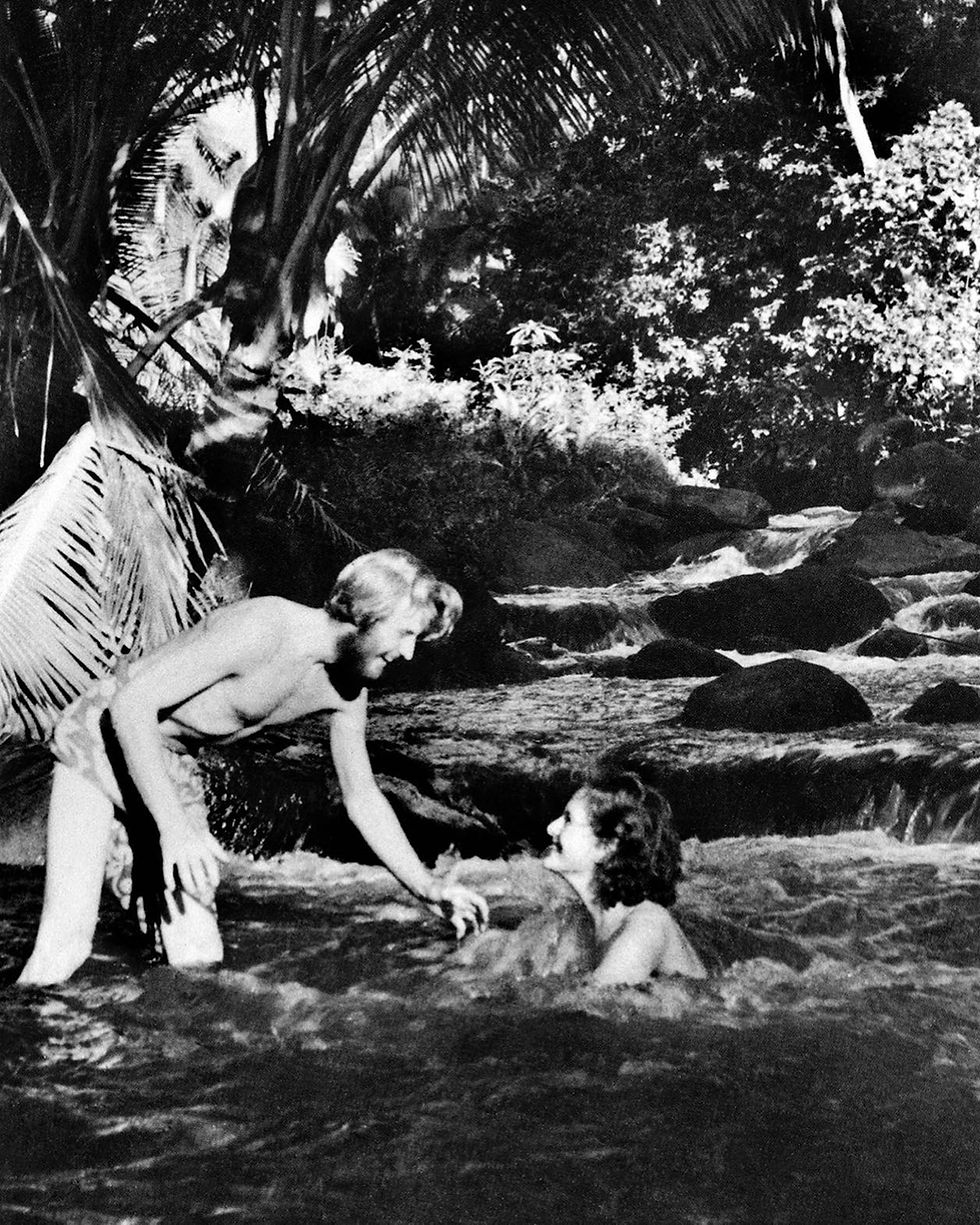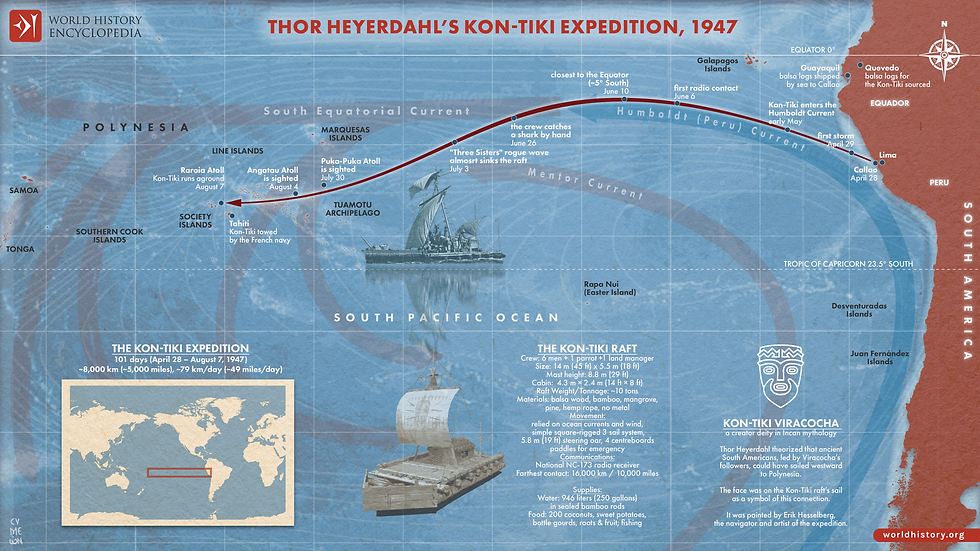Thor Heyerdahl: The Explorer Who Sailed Across Time
- Windfarer

- Aug 18
- 3 min read
Updated: Aug 21
The Explorer Who Sailed Across Time
By Windfarer, August 18, 2025

Prologue
In 1947, a fragile balsa raft named Kon-Tiki drifted across the Pacific, its six-man crew defying towering waves and skeptics alike. Leading them was Thor Heyerdahl, a Norwegian whose bold theory—that ancient South Americans could have sailed to Polynesia—challenged history’s certainties. A decade earlier, on the remote island of Fatu Hiva, Heyerdahl’s dream took root, sparked by a year of living among Polynesian traditions. His life was a tapestry of adventure, woven from courage and curiosity. Who was this man who dared to sail where scholars feared to tread? This article dives into Heyerdahl’s transformative years, his daring expeditions, and a legacy that still stirs debate.
The Spark of Fatu Hiva

Born in Larvik, Norway, in 1914, Thor Heyerdahl’s passion for exploration bloomed early, fueled by studies in zoology and anthropology. In 1937, at age 23, he and his new wife, Liv Coucheron Torp, sought a simpler life on Fatu Hiva, a lush, volcanic island in the Marquesas. Living in a self-built hut, they embraced the rhythms of Polynesian life—eating wild fruit, fishing with locals, and studying ancient artifacts. Heyerdahl noticed striking similarities between Polynesian statues and South American designs, sowing the seeds of his theory that ancient mariners crossed the Pacific. “The legends of Tiki, a Polynesian hero, echoed South American myths,” he later wrote (Fatu-Hiva: Back to Nature, 1974). Despite tropical illnesses and isolation, their year-long adventure, as anthropologist Robert Suggs noted, shaped Heyerdahl’s “unorthodox but compelling” ideas (Suggs, Polynesian Origins, 1960).

Fatu Hiva, where a bold hypothesis was born
The Kon-Tiki Expedition: Testing the Theory
Heyerdahl’s Fatu Hiva insights drove his most famous feat: the 1947 Kon-Tiki expedition.
To prove ancient South Americans could have reached Polynesia, he built a balsa raft using only pre-Columbian materials—logs, hemp, and sheer determination.

The 4,300-mile, 101-day voyage battled storms and sharks, captivating the world. The Oscar-winning Kon-Tiki documentary (1950) brought his story to millions. National Geographic later called it a “challenge to conventional wisdom” (National Geographic, 1997). Yet critics argued that one voyage didn’t confirm historical migration, a debate still alive today. For Heyerdahl, Kon-Tiki was a tribute to the ancient mariners he first imagined on Fatu Hiva. Could such journeys have shaped human history?

Heyerdahl’s Kon-Tiki crew aboard the raft, proving ancient voyages were possible
Beyond the Pacific: A Legacy of Exploration

Heyerdahl’s adventures didn’t end with Kon-Tiki. In 1969 and 1970, he sailed papyrus boats, Ra and Ra II, across the Atlantic, testing links between ancient Egyptians and the Americas. In 1978, his Tigris expedition traced Mesopotamian trade routes. These journeys, chronicled in books like The Kon-Tiki Expedition (1948), inspired generations.
Recent genetic studies, such as a 2020 Nature report, suggest limited South American-Polynesian contact, offering partial vindication (Nature, 2020). Though his methods—more daring than scientific—spark controversy, Heyerdahl’s Fatu Hiva-inspired vision reshaped how we view ancient connectivity.
Conclusion
Thor Heyerdahl was more than an explorer; he was a dreamer who challenged the boundaries of possibility. His expeditions, from the perilous Kon-Tiki to the ambitious Ra and Tigris, showed that ancient peoples might have been far more connected than scholars once believed. His work, though debated, continues to inspire archaeologists, adventurers, and storytellers. Why do Heyerdahl’s journeys still capture our imagination? Perhaps because they remind us that history is not a closed book but a sea of mysteries waiting to be sailed. Share your thoughts in the comments: What drives someone to risk everything for a theory?

Further Reading
Smithsonian: “Kon-Tiki Sails Again” – An article exploring Heyerdahl’s voyage and its origins in Fatu Hiva.
YouTube: “The Kon Tiki Expedition” – A documentary detailing Heyerdahl’s Pacific adventure and crew.
BBC: “Thor Heyerdahl film sets sail to Toronto” – Coverage of a film dramatizing the Kon-Tiki expedition.
World History Encyclopedia: “Kon-Tiki Expedition” – A detailed overview of Heyerdahl’s epic crossing and theories, including Fatu Hiva.
Nature: “Genetic Evidence of Polynesian-South American Contact” – A 2020 study supporting Heyerdahl’s ideas.




Comments